Water quality and the Sustainable Development Goals
By Eduardo Cyrino de Oliveira Filho, researcher at Embrapa Cerrados

Among the various operations that rural producers have to carry out and complete their production process, one of the most important is the application of chemical protection products to the crop. The use of application equipment such as sprayers has become essential to achieve high productivity and product quality.
Although sowing and harvesting are fundamental operations for production, the sprayer has acquired a status of enormous importance in this context of efficient and quality agriculture. Considering all the machines used in the production process, the sprayer is the machine that performs the most hours of work throughout the crop cycle.
As a machine vital to the process, the sprayer must be precise, efficient, durable and also meet all the safety requirements for people and the environment in which it is located. Few machines have seen such intense recent development in recent years.
The Fendt Rogator is derived from the Ag-Gator, produced in the 1960s-70s in the USA, later renamed TerraGator, and is still produced under this name today. The Rogator was derived from this equipment, starting production in 2012, with the 900 series since 2017. The 900 series Fendt Rogator, model 934H manufactured in the USA, in Jackson, Minneapolis, by Fendt was brought and launched at Agrishow 2023, in Ribeirão Preto (SP). Although there are already commercially available sprayers, the equipment we tested is part of a pre-series and units will soon be available for delivery to customers.
The Fendt Rogator 934H is a global product, with the model sold here in Brazil exactly the same as that sold in the North American market and in other countries where the brand operates. In the USA, the 900 series is made up of two other models, the RG932 and the R937. The RG934 models have two versions, R934 and RG934H, and the RG937, also in two versions, RG937 and RG937H. The H in the designation represents the high free space available in these versions.
To test it and learn about its characteristics and operating conditions, the team from Revista Cultivar Máquinas and the UFSM Agrotechnology Laboratory went to the municipality of Sidrolândia, in the state of Mato Grosso do Sul, specifically at Fazenda Recanto, belonging to the Grupo Clover.
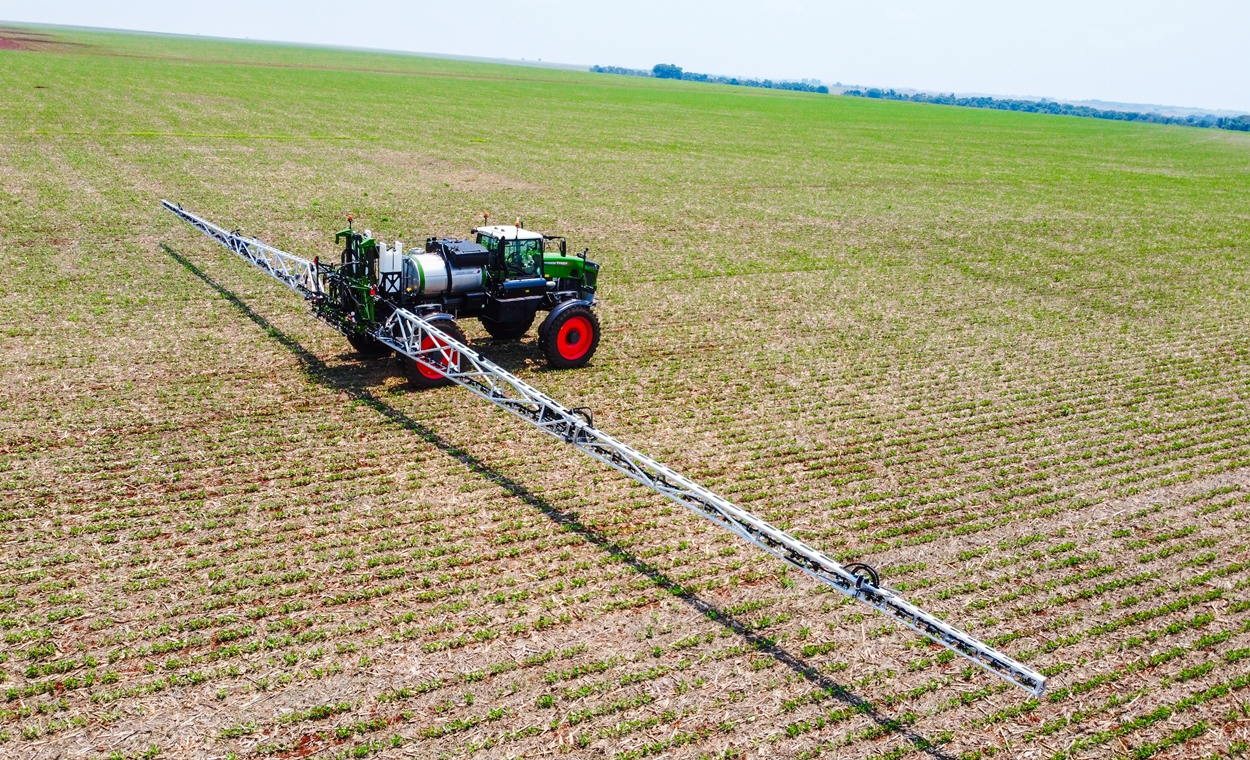
The six-cylinder, 8.400 cubic centimeter (cm3) AGCO Power engine, which produces 340 hp and 1.600 Nm of torque, meets the most stringent emission limit standards in force in the USA, which is Tier IV Final (T4F) with the SCR system, which uses urea as a catalyst and a particulate filter (DPF) to eliminate combustion residues from the environment. The engine is approved by the manufacturer to use the two types of Diesel fuel offered on the national market, S500 and S10. A 567-liter fuel tank guarantees autonomy for the equipment.
The forward position of the engine provides excellent weight distribution, providing comfort to the operator and safety when traveling at higher speeds, due to the distribution of weight between the components at the front and rear of the vehicle. During testing and moving the vehicle, we did not see longitudinal oscillations, which are very common in other equipment.

The traction and wheel movement control system is the AWD Smart Drive, which is integrated with the engine, through electronic management. This automatically controls engine speed and vehicle speed. This is very important for maintaining a better application standard, in addition to other advantages such as reduced fuel consumption. Even with variations in terrain, inclines and declines, the individual speed of each wheel is controlled and the speed is maintained. To transmit independent and continuous movement of the four driving wheels, electronic resources and hydraulic power variation are used. Through individual hydraulic motors and electronics actuation, the rotation of each wheel is controlled by individual rotation sensors.
One of the most important parts of a self-propelled sprayer is that related to all the components that pressurize the liquid and send it to the boom for application.
The equipment we tested has a 3.500-liter syrup tank, but Fendt offers a 4.200-liter syrup tank as an option, both made of stainless steel. In addition to the durability of stainless steel, several other advantages, such as easy cleaning and reduced deposits in corners, can be concluded by visualizing the system adopted.
In addition to the main tank, the equipment has another 523-liter clean water tank that serves the LiquidLogic system. LiquidLogic performs complete syrup management, from the front supply point to the machine's automatic cleaning system. A third tank of 40 liters of clean water is used for operator hygiene.
Working together with the deposit, there is a direct injection system, placed on the left side of the equipment, which allows the commercial product to be mixed, forming the syrup. At the rear of the Rogator there are two tanks of 150 liters each, for the direct injection system to operate, so that two different products or mixtures can be placed, which the system is responsible for mixing in the doses required for the particular application.
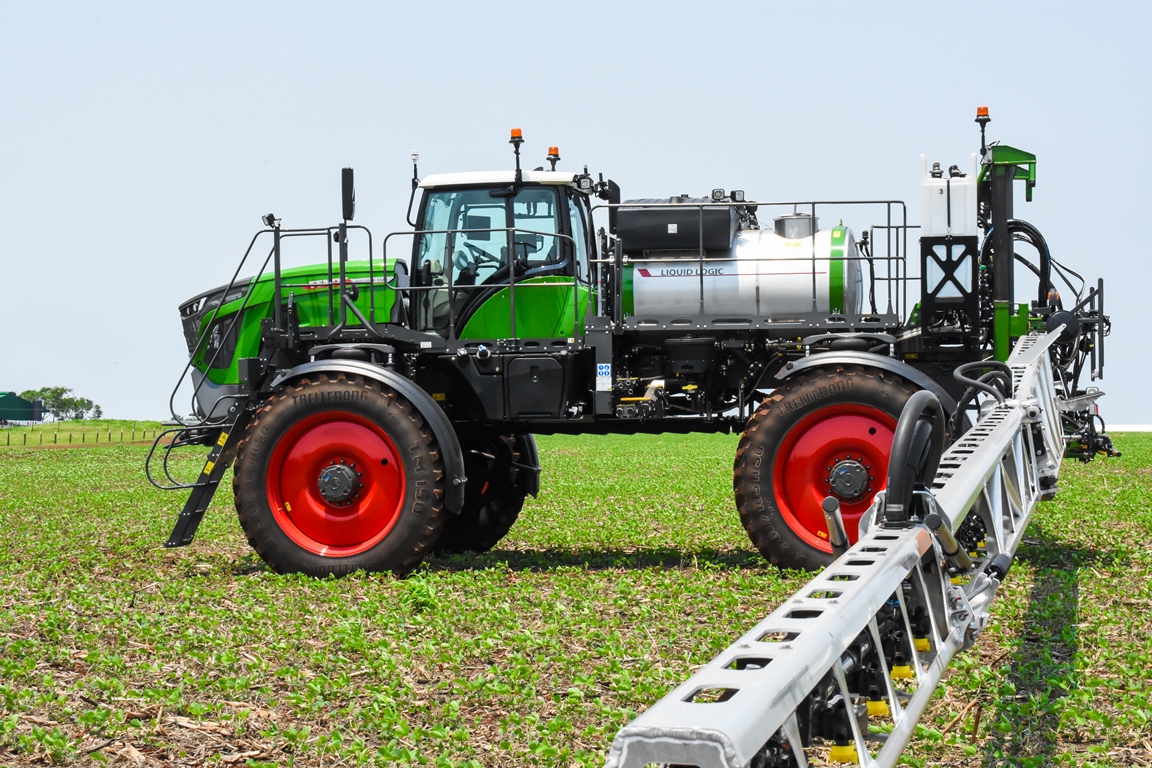
Filling the tank with water or even ready-made syrup, as is currently common in many rural establishments, occurs both from the side, close to the direct injection panel, and from the front, below the engine compartment. With this possibility and to facilitate the operation, two control panels were arranged, each placed close to the side and front quick coupling socket. In the test, we saw how easy it was to use the panels. The system that uses ready-made syrup is the one that best combines application efficiency, as it is faster and safer and takes advantage of the machine's full potential.
The spray pump is from the Hypro brand and has an interesting wear protection system, with a coolant, which prevents it from overheating and protects the pump, increasing its duration.
The LiquidLogic system, which is original to the Rogator and is now used in other products in the AGCO sprayer line, causes the recirculation of the liquid fluid throughout the circuit from the tank, passing through the mixing and refilling system, recovering the product that remains inside the tank at the end of the application, resulting in several advantages such as product savings, environmental protection and elimination of blockages. It also acts as an automatic cleaning system. This is a unique feature of this equipment.
The Rogator 934H, more than a sprayer, is a vehicle, suitable for traveling at higher speeds and developed to face the difficulties and irregularities of agricultural land. Through the transmission system, it is possible to travel in the field, in operation, up to a limit of 43 km/h application speed, normally done between the range of 20 to 22 km/h. Travel speed in transport is limited to 55 km/h. For operation, including maneuvers with the VarioCruse system, it is possible to program two speeds and vary them in these two ranges using the monitor.

To achieve these operational limits, the manufacturer provided the equipment with several devices that aim for operational safety, combined with the maintenance of conditions suitable for proper functioning and compliance with quality and safety requirements in liquid product application technology. It all starts with a chassis adapted to the rigor of the operation. A robust all-bolt structure is used, with screws called buckbolts. These are special screws, with a locking system against loosening and loosening.
The rear and front axles are joined to the main chassis by means of air bag-type shock absorbers, which accumulate pressure and, through the active suspension system, can inflate and deflate to absorb impacts and oscillations, in an approximate stroke. 40 cm.
We saw that the wheelset columns - known as shins -, where the wheelsets are connected, have two guide cylinders and, in the middle, a hydraulic piston, which provides lifting and lowering. This system proves to be very effective in terms of robustness, as well as preventing wear and tear. The tires fitted to the tested model were sized 380/105R50, on both axles.
For vehicle movement, we saw several interesting solutions that are not present in most of the equipment we know on the Brazilian market. The drive of the hydraulic pumps that move the vehicle is directly connected to the engine output, which improves the system's efficiency. There are three pumps placed in series and using the same hydraulic oil. The first pump is exclusively for the movement transmission system to the wheelsets. The second pump serves the spraying system and the third pump is dedicated to general functions, such as moving the ladder to access the cabin, adjusting the gauge, adjusting the height of the vehicle, among other accessory functions. To achieve this, the sprayer has a 136 liter capacity tank for hydraulic oil.
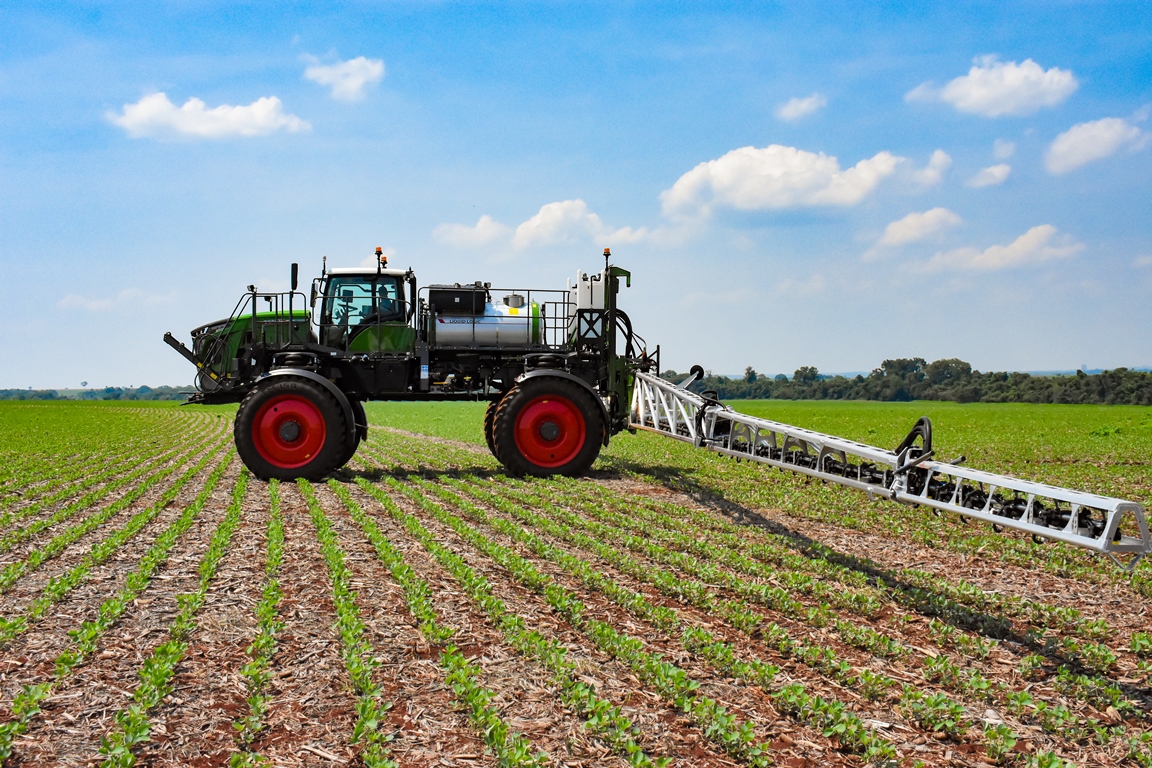
When moving, the manufacturer provided four steering alternatives, one for the front wheels, another for the rear wheels, one for both wheels and a fourth in crab mode, where both wheels turn to the same side, causing the vehicle to move. diagonally, to the side. This technology, called GatorTrak™ steering, helps with headland maneuvers, making it possible to reduce maneuvering space, controlling it directly from the monitor in the cab and reducing crushing and reducing space.
During the test, our attention was drawn to a protector placed at the bottom of the vehicle, consisting of a flat bottom, which can be easily opened into three sections, for inspection and maintenance operations. This is very useful to avoid damage to large crops. It can also be seen that very effective protection work was carried out on all hydraulic hoses in this equipment.
One interesting feature we saw in the Rogator's handling is related to the suspension geometry. The wheelsets have positive camber, in relation to the vertical plane, this causes a reduction in the width of the shank and a reduction in the damage that the wheelsets can cause to the crop arranged in a row.
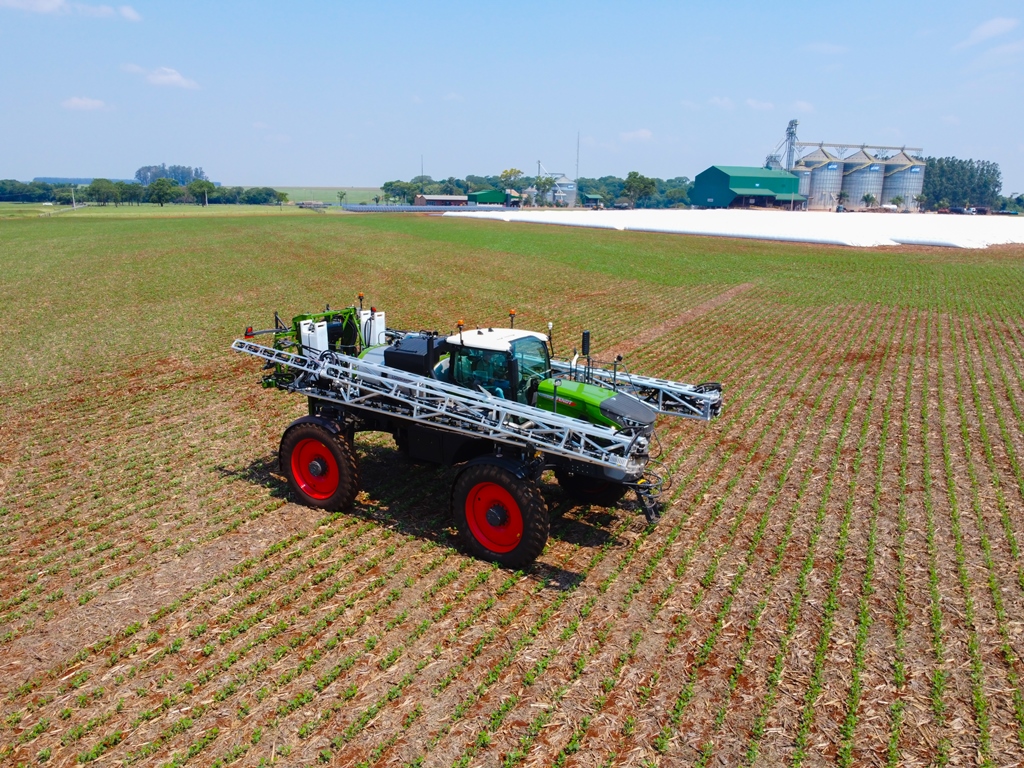
The gauge adjustment, which is the center-to-center distance of the tires on each axle, is done directly from the operator's station using hydraulic cylinders. To reduce the effort, it is recommended to do this, with the vehicle moving, at a very low speed. There is no need for checking or mechanical blocking, with the measurement shown on the monitor to the operator. The measurement is infinite between 3,04 m and 3,86 m.
The height of the equipment is easily varied depending on the type of application using the Aplic Height system. For low crops or in the early stages of crop development, the bar and the vehicle itself can be positioned with a smaller standard free space, around 1,52 m to improve the performance of the application and the vehicle. For tall crops, in advanced stages of development, such as treatments at the end of the corn cycle, the H series allows the distance from the soil to the bottom of the equipment to be increased to up to 1,93 m in less than 45 seconds. When the vehicle is at its maximum height, for safety reasons the speed is limited to 24 km/h.
The application bar of the Rogator 934H is made entirely of aluminum, divided into three sections, with nozzle-to-nozzle flow cut-off control. It connects to the vehicle through a tower system, which is a rear support that moves the bar vertically, changing its height. Visually, this painting is extremely robust. For the Brazilian market, application bar lengths are currently 36 or 40 m, depending on the customer's option. On the equipment we tested, the bar was 40 m long.
The bar in the closed position is ready to travel at higher speeds, which is why the vehicle's geometry brings more than half of the weight to the front, improving transport stability. When the bar is opened and in the operating position in the field, it is locked and the weight is distributed 60% to 40%.
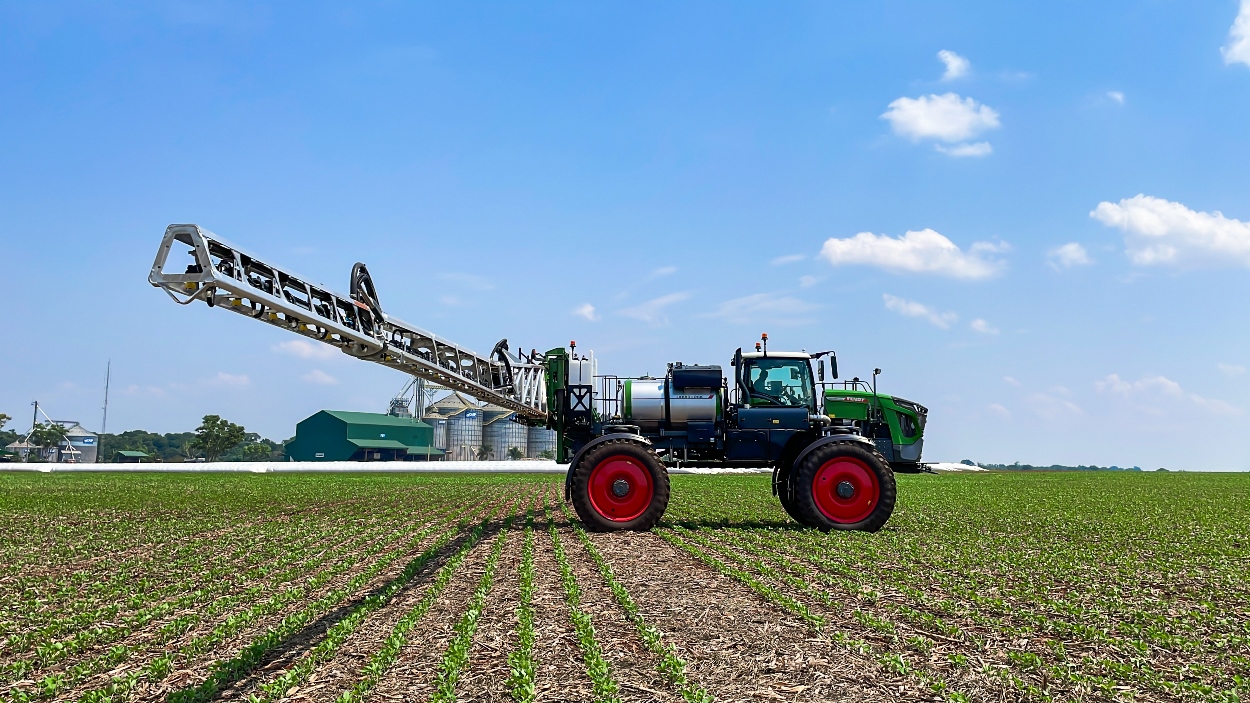
In the field and during application operations with the boom open, a slight oscillation of the vehicle is noted, copying the undulations of the terrain while the boom remains stable. The leveling of the bar and its vertical position are controlled by five height sensors. This allows for greater travel speed compared to other equipment that does not have the technology present in the Rogator. In a rear view, you can see the action of two pistons placed in the bar, which have the mission of controlling lateral oscillation.
Although the product has a high degree of technology, being full of compensation, variation and monitoring features, it is necessary to highlight some more outstanding technologies, which differentiate it from others offered on the Brazilian market.
The OptiPulse system controls the amount of product to be distributed through the nozzles in each particular situation. The pressurization system is combined with nozzle-to-nozzle cutting with PWM valves and flow sensors to place a precise quantity at the location recorded by the application map. When cornering, TurnLogic technology changes the flow to compensate for the different speeds traveled by the nozzle and its position on the bar.
On the roof of the cabin is the WhatchDog weather station, which provides information that is used to improve application standards. All this information can be displayed, both on the vehicle terminal and on the application terminal. This equipment is standard for the model sold in Brazil.

Shark antennas are placed on the roof of the cabin, which serve the telemetry system, which is also standard for this model, and Slingshot antennas, which are antennas dedicated to recording position only for the application. The telemetry system allows remote communication via Fendt Connect. The autopilot used in this equipment is the Fendt Guide RS1.
The horizontal positioning of the bar is carried out by Fendt OptiHeight technology, which uses five position sensors, which act via the dopler effect to detect the horizontal plane of the soil or even the crop and move the bar vertically, maintaining the optimal application height.
To control the flow of the product through the nozzles, the OptiStop™Control technology uses electronic ball valves, which switch off and on, instantly controlling the product output. Therefore, with PWM valves, the flow is cut off nozzle by nozzle as standard on this model. This is essential to save product and protect the environment, avoiding overlapping applications between passes.
Accessing via a retractable ladder leads to a large platform, with guardrails on the left and rear sides of the cabin. Entering through the single door on the left side you reach the interior of a large, category 4 cabin, the same as the one used on Fendt tractors. Cabs in this classification are capable of fully protecting operators against suspended dust, aerosols from applications and even vapors resulting from evaporation. For this protection, activated carbon filtration and positive pressure are available. Positive pressure is very important to contain the entry of fluids from outside into the cabin, physically insufflating air in a homogeneous and constant way, external pressure at atmospheric level does not induce entry into a closed environment. In order to comply with global safety standards, the cab has an emergency exit on the roof.
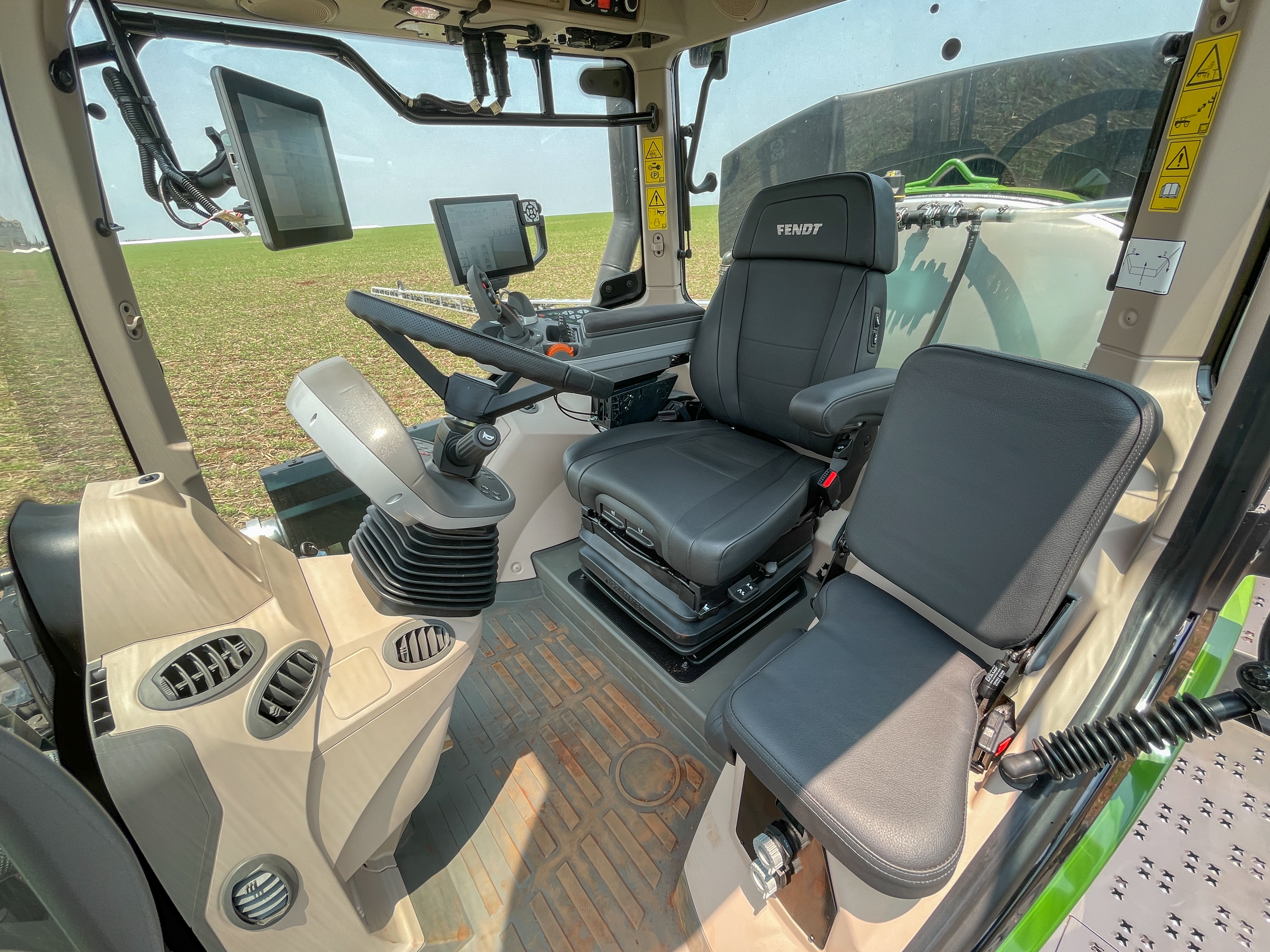
In the center of the cabin, a premium seat with pneumatic absorption covered in leather, which is standard in this model, has heating and lumbar correction. To the left of the main seat, a companion seat, also available in the standard version, is mainly used for training new operators.
To the operator's right, an armrest, similar to those used on Fendt harvesters, contains the secondary controls and the main, multifunctional joystick that controls the direction and intensity of the machine's movement. On this console, two monitors provide information to the operator. The first, called NT01, is the Fendt Varioterminal™, responsible for machine management information, including maintenance. On the second monitor, called Fendt Viper® 4+ Raven, placed further in front of the console, all information related to the application operation is presented in detail. To give an idea of the technology involved, simply enter the volume you want to apply per area and the working pressure you want to work with and it calculates the application pattern for each tip. To do this, it uses pre-configured information that must be included by the responsible technician. On this second monitor, it is possible to receive precise and instant information on the variable rate application (VRA) of up to ten products and create a mapping with the areas already applied and to be applied.

In addition to all the comfort of the cabin, there are other features, such as the presence of a reversing camera and the vast glass area. The amount of lighting and reflective devices is impressive, with multiple spotlights in all directions. To further facilitate the work of the modern operator, who uses a high-performance machine like this, a microphone is placed on the right side of the cab, allowing hands-free operation when answering telephones and radios.
With all the resources we saw in the field and explained in this text, and considering the version we tested, with a 3.500 liter tank and a 40 meter long application bar, it is fully possible, under test conditions, to consider an operational capacity of approximately 800 hectares per day. Using ideal conditions and excellent logistics, more than a thousand hectares can be reached per working day.
But what impressed us most in this field test with the Fendt Rogator 934H was the amount of resources applied to the same machine, in its standard version. The highlights begin with the driver's seat, with the comfort of the cabin and access to it, and continue with the technologies available for a safe and qualified application. Elements that are optional on other machines on the market are available in the entry-level version.

Receive the latest agriculture news by email